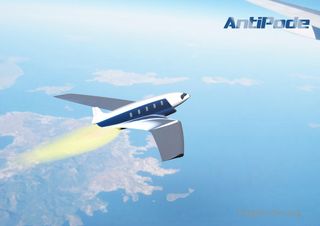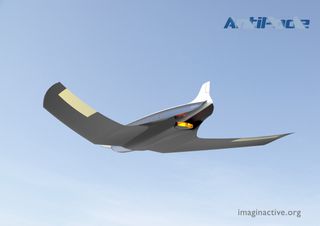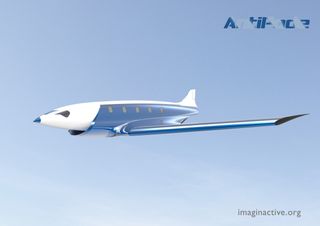This Jet Promises to Fly You From NYC to London in 11 Minutes
How fast is Mach 24? A little over 18,000 miles per hour, which could allow the Antipode Concept jet to fly from NYC to London in the time it takes to eat lunch.
When the Concorde supersonic jet made its last flight back in 2003, it felt like the aviation industry was taking a step back instead of boldly soaring into the future. That’s why the Antipode concept jet is so exciting, because it doesn’t promise to simply incrementally improve air travel, but to shatter expectations with the promise of getting from New York City to London in just 11 minutes.

The Antipode is the brainchild of Charles Bombardier (grandson of the inventor of the snowmobile and Bombardier founder Joseph-Armand Bombardier), who just a few months ago showed off designs for Skreemr, a 75-passenger scramjet that can reach speeds up to Mach 10. But the Antipode makes even the Skreemr look slow, because this private 10-seat jet features both rocket boosters and scramjets, which allow it to reach a staggering top speed of Mach 24, or more than 18,000 miles per hour.
MORE: What's Next for Drones: Super Selfies, GoPro Karma and Fuel Cells?
Unfortunately, while the Antipode sounds like an international businessman’s dream ride, there are a ton of issues that could stop this concept from becoming reality. First of all, no company or organization--not even NASA--has found a way to make a reliable scramjet-equipped aircraft.

Then, Bombardier has to figure out a way to prevent the plane for melting, exploding or simply ripping apart due to the intense heat and air pressure the plane will have to deal with at those speeds. Bombardier even admitted in an interview with Forbes that “I am not sure the materials able to withstand the heat, pressure, and structural stress for this application have been invented yet.”
On the heat front, an idea by Wyle engineer and former DoD RIAC director Joseph Hazeltine proposes that nozzles located in the nose of the aircraft may be able to keep temperatures down. By shooting supersonic air down in a direction opposite to the plane’s path, the Antipode could induce an aerodynamic phenomenon known as ‘long penetration mode,’ which would create a drop in surface temperature through aeroheating and a reduction in shockwave caused by breaking the sound barrier.

It was this theory that became the spark for the Antipode concept, and is the reason why Bombardier went back to the drawing board to create a new design so soon after unveiling the Skreemr.
Sign up to get the BEST of Tom’s Guide direct to your inbox.
Upgrade your life with a daily dose of the biggest tech news, lifestyle hacks and our curated analysis. Be the first to know about cutting-edge gadgets and the hottest deals.
This still leaves the Antipode’s design as a potential issue, because LPM works best on rocket-shaped craft instead of the winged design seen in Bombardier’s concept drawings. One problem at a time, it seems.
The chances that the Antipode ever sees production could be quite slim, but it’s big ideas like this that gives innovators something to work towards. Besides, wouldn’t everyone like to spend a little less time commuting?
Sam is a Senior Writer at Engadget and previously worked at Gizmodo as a Senior Reporter. Before that, he worked at Tom's Guide and Laptop Mag as a Staff Writer and Senior Product Review Analyst, overseeing benchmarks and testing for countless product reviews. He was also an archery instructor and a penguin trainer too (really).
